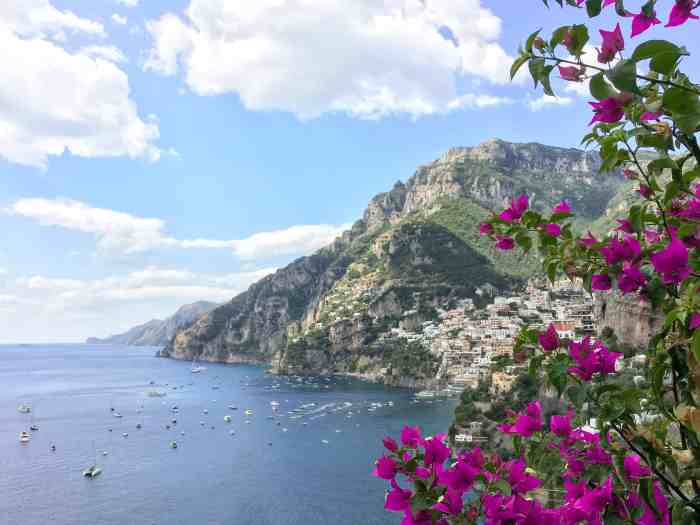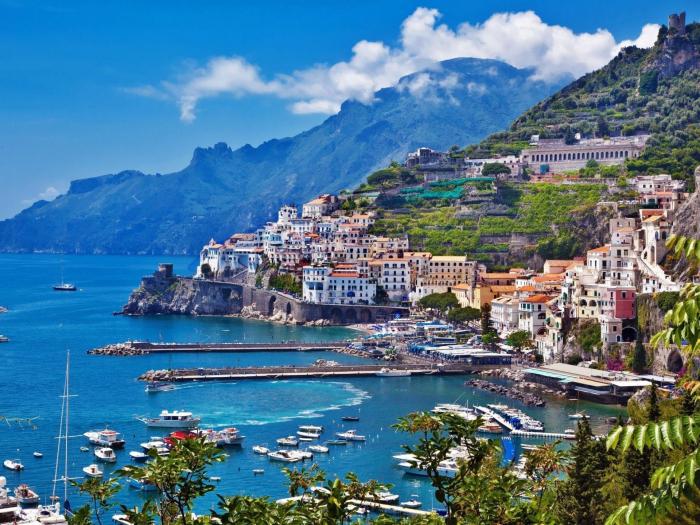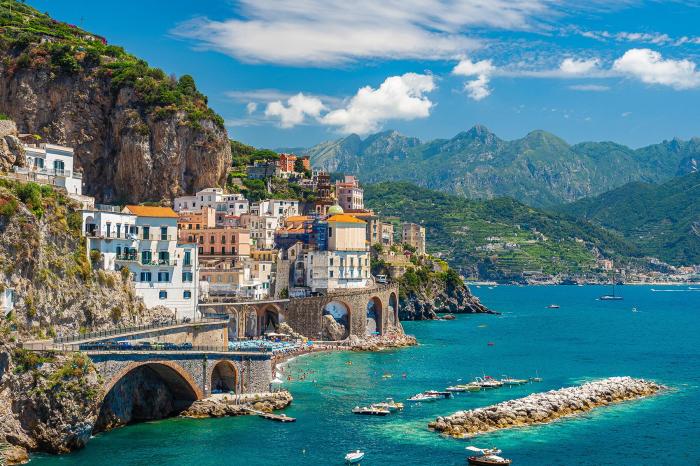Amalfi, a breathtaking coastal town nestled on the picturesque Amalfi Coast, beckons travelers with its rich history, stunning natural beauty, and vibrant cultural heritage.
From its role as a maritime powerhouse in the Middle Ages to its architectural marvels and enchanting coastline, Amalfi offers a captivating tapestry of experiences that will leave an unforgettable mark.
Historical Significance

Amalfi, nestled on the picturesque Amalfi Coast, boasts a rich historical legacy that has shaped its architectural heritage and maritime prominence.
Amalfi, with its dramatic coastline and picturesque towns, is a popular destination for travelers seeking a blend of culture and nature. Those who enjoy the charm of Amalfi may also appreciate the beauty of Annecy France , a stunning alpine town known for its crystal-clear lake and medieval architecture.
Annecy offers a different yet equally captivating experience, inviting travelers to explore its rich history and embrace the tranquility of its surroundings. Despite their contrasting landscapes, both Amalfi and Annecy embody the allure of European destinations, offering unforgettable experiences for discerning travelers.
Amalfi’s historical timeline unfolds as follows:
- 839 CE: Amalfi becomes an independent maritime republic, capitalizing on its strategic location for trade.
- 10th-11th centuries: Amalfi flourishes as a major center of maritime trade, connecting the East and West.
- 1137 CE: Amalfi is conquered by the Normans, who establish a feudal system.
- 1343 CE: A devastating earthquake and tsunami strike Amalfi, causing significant damage.
- 19th century: Amalfi experiences a revival as a tourist destination, attracting visitors with its scenic beauty and historical charm.
Role in Maritime Trade
During the Middle Ages, Amalfi played a pivotal role in maritime trade, serving as a hub for merchants from across the Mediterranean and beyond.
Amalfi’s maritime prowess was driven by several factors:
- Strategic Location: Amalfi’s sheltered harbor and proximity to major trade routes made it an ideal base for ships.
- Skilled Seafarers: Amalfi’s skilled shipbuilders and navigators were renowned for their expertise.
- Commercial Laws: Amalfi established a set of maritime laws, known as the Amalfi Table, which regulated trade and navigation.
Architectural Heritage, Amalfi
Amalfi’s architectural heritage is a testament to its past prosperity and cultural influences.
Among the most notable landmarks is the Amalfi Cathedral, built in the 11th century. The cathedral features a blend of Byzantine, Romanesque, and Gothic architectural styles, showcasing the cultural influences that shaped Amalfi.
Other notable architectural landmarks include:
- The Chiostro del Paradiso (Cloister of Paradise): A beautiful cloister adorned with intricate mosaics and columns.
- The Arsenale della Repubblica (Republic’s Arsenal): A former shipyard that now houses the Maritime Museum.
- The Valle dei Mulini (Valley of the Mills): A picturesque valley dotted with ancient watermills.
Natural Beauty

The Amalfi Coast is renowned for its breathtaking coastline and pristine beaches. The rugged cliffs, picturesque villages, and vibrant local flora and fauna create a landscape of unparalleled beauty.
The coastline stretches for over 50 kilometers, offering a diverse range of beaches. From the secluded coves of Conca dei Marini to the popular tourist destination of Positano, each beach has its own unique charm.
Geographical Features
- Steep cliffs: The Amalfi Coast is characterized by towering cliffs that plunge into the sea, creating dramatic views.
- Picturesque villages: Nestled amidst the cliffs are charming villages such as Amalfi, Ravello, and Atrani, each with its own unique architecture and history.
Flora and Fauna
The region is home to a rich variety of plant and animal life. The slopes of the mountains are covered in lush vegetation, including olive groves, lemon trees, and vineyards.
The marine life is equally diverse, with a variety of fish, dolphins, and whales inhabiting the waters off the coast.
Cultural Heritage: Amalfi

Amalfi’s cultural heritage is a tapestry woven from centuries of tradition, craftsmanship, and vibrant celebrations. The town’s artisans continue to practice ancient crafts, creating exquisite ceramics, textiles, and leather goods that reflect the region’s rich history.
Amalfi’s cuisine is a culinary symphony of fresh seafood, fragrant herbs, and the vibrant flavors of the Mediterranean. Local specialties include succulent grilled octopus, delicate seafood salads, and fragrant lemon-infused dishes.
Vibrant Festivals and Events
Throughout the year, Amalfi hosts a calendar filled with lively festivals and events that showcase the town’s cultural spirit. The highlight of the year is the Regatta Storica, a traditional boat race that commemorates the maritime prowess of the Amalfi Republic.
- Regatta Storica: A thrilling boat race that recreates the historic rivalry between the maritime republics of Amalfi, Pisa, Genoa, and Venice.
- Feast of Sant’Andrea: A religious festival honoring the patron saint of Amalfi, featuring a solemn procession and lively fireworks.
- Amalfi Coast Music & Arts Festival: A summer festival that brings together musicians, artists, and performers from around the world.
Tourism and Recreation

Amalfi is a vibrant tourist destination that offers a plethora of attractions and recreational activities. From historical landmarks to stunning natural beauty, there’s something for every traveler.
Popular Tourist Attractions
Amalfi boasts a rich cultural heritage, and visitors can explore numerous museums, churches, and viewpoints.
Amalfi’s stunning coastline and vibrant atmosphere draw visitors from around the globe. However, for those seeking a unique wildlife experience, a day trip to the renowned adelaide zoo is highly recommended. This award-winning zoo boasts over 2,500 animals from all corners of the world, providing an unforgettable encounter with nature.
After exploring the diverse wildlife, return to Amalfi’s picturesque shores for a breathtaking sunset.
- Amalfi Cathedral: This iconic 9th-century cathedral is adorned with intricate mosaics and a beautiful bell tower.
- Museo Civico: This museum houses a collection of artifacts from Amalfi’s past, including ceramics, paintings, and sculptures.
- Valle delle Ferriere: This picturesque valley offers stunning views of the surrounding mountains and the Amalfi Coast.
- Villa Cimbrone: This luxurious villa features beautiful gardens, a terrace with panoramic views, and a museum dedicated to ancient Greek and Roman art.
Outdoor Activities
In addition to its cultural attractions, Amalfi offers a wide range of outdoor activities.
Amalfi’s captivating history and stunning architecture make it a must-see destination for cultural tours in Europe. From the iconic Duomo to the picturesque streets, Amalfi offers a glimpse into Italy’s rich cultural heritage. Explore the region’s ancient ruins, immerse yourself in the local cuisine, and discover the timeless beauty that makes Amalfi a cultural gem.
| Activity | Description |
|---|---|
| Hiking: | Explore the scenic trails of the Lattari Mountains, offering breathtaking views of the Amalfi Coast. |
| Boating: | Take a boat trip along the coastline, visiting hidden coves and beaches. |
| Swimming: | Enjoy the crystal-clear waters of the Mediterranean Sea at one of Amalfi’s many beaches. |
| Scuba Diving: | Discover the underwater world of the Amalfi Coast, with its vibrant marine life and coral reefs. |
| Rock Climbing: | Challenge yourself on the rugged cliffs of the Amalfi Coast, offering routes for climbers of all levels. |
Planning a Trip
To make the most of your trip to Amalfi, consider the following tips:
- Visit during the shoulder seasons (April-May or September-October) to avoid the crowds and enjoy more pleasant weather.
- Book accommodation in advance, especially if traveling during peak season.
- Consider purchasing a Campania Artecard, which offers discounted admission to many museums and attractions.
- Learn a few basic Italian phrases to enhance your interactions with locals.
Last Word

Amalfi’s allure extends beyond its historical and natural treasures. Its traditional crafts, delectable cuisine, and vibrant festivals paint a vibrant portrait of a living culture that has thrived for centuries.
Whether you seek historical immersion, breathtaking landscapes, or cultural enrichment, Amalfi promises an extraordinary journey that will ignite your senses and leave you yearning for more.
User Queries
What is Amalfi famous for?
Amalfi is renowned for its historical significance as a maritime republic, its stunning coastline and beaches, and its rich cultural heritage.
What are the must-see attractions in Amalfi?
Top attractions include the Amalfi Cathedral, the Emerald Grotto, the Path of the Gods hiking trail, and the Ravello Gardens.
What is the best time to visit Amalfi?
Spring and fall offer the most pleasant weather, while summer can be crowded and hot. Winter is generally mild, but some attractions may have reduced hours.